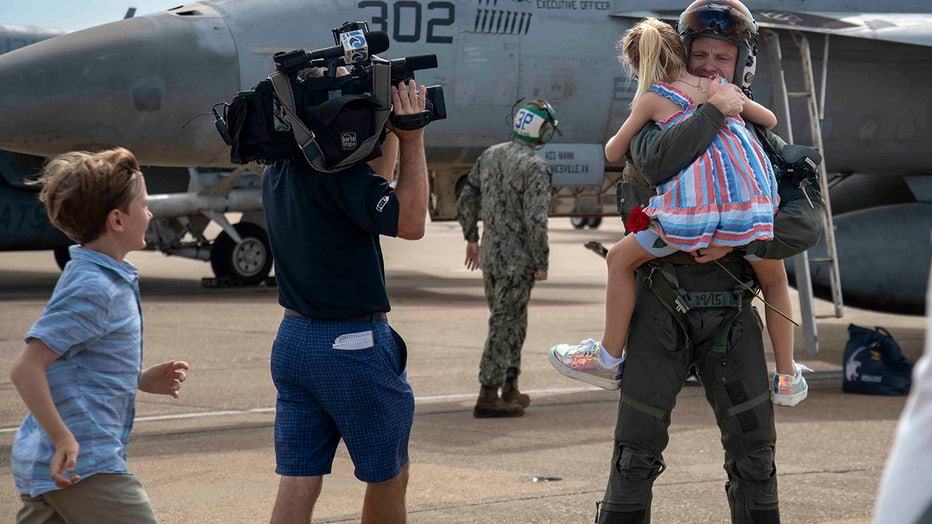Navy pilots welcomed home after months of fending off Houthi attacks

Lt. Cmdr. Robert Nelson, assigned to the "Rampagers" of Strike Fighter Squadron (VFA) 83, greets his wife during the squadron's homecoming. (U.S. Navy photo by Mass Communication Specialist 2nd Class Megan Wollam/Released)
NORFOLK, Virginia - Thousands of sailors are returning home to the U.S. after months in the Middle East where they faced off in what some experts are calling the most intense ongoing naval battle since World War II.
Six fighter jet squadrons from Carrier Air Wing 3 were among the first to arrive home Friday as the USS Dwight D. Eisenhower aircraft carrier strike group sailed home from the Red Sea.
After their formation flight of F/A-18E Super Hornets roared over the waiting family members at Naval Air Station Oceana, they touched down to be greeted by salutes and hugs on the runway.
Intense combat
The Eisenhower strike group, which includes three other warships, was protecting private ships as well as U.S. allies in a vital Red Sea corridor that leads to the Suez Canal and into the Mediterranean.
Iran-backed Houthi rebels in Yemen have been using drones and missiles to attack ships linked to Israel, the United States or Britain in what they say is a campaign to support Hamas, though they frequently have targeted ships with no clear links to Israel or its supporters, imperiling shipping in a key route for global trade.
One notable attack on January 9 involved U.S. ships and aircraft downing 18 Houthi drones, two anti-ship cruise missiles, and a ballistic missile.
Over the nearly nine-month deployment, the group completed more than 13,800 flights, totaling about 31,500 hours, according to Stars and Stripes.
In their own words

Families welcome home Sailors assigned to the "Wildcats" of Strike Fighter Squadron (VFA) 131 during the squadron's homecoming. (U.S. Navy photo by Mass Communication Specialist 2nd Class Megan Wollam/Released)
"It was very dynamic. It was something we really have not seen – for the carrier strike group to be that close to that kind of fight – since World War II. It has been a constant evolution," Capt. Marvin Scott, commander of the air wing, told Stars and Stripes on Friday.
Cmdr. Benjamin Orloff, a Navy pilot, said that most of the sailors, including him, weren't used to being fired on given the nation's previous military engagements in recent decades.
"It was incredibly different," Orloff said. "And I’ll be honest, it was a little traumatizing for the group. It’s something that we don’t think about a lot until you’re presented with it."
What’s next
The USS Theodore Roosevelt strike group will replace the Eisenhower on scene in the Red Sea, where the Houthi attacks are expected to continue.

Families welcome home Sailors assigned to the "Rampagers" of Strike Fighter Squadron (VFA) 83 during the squadron's homecoming. (U.S. Navy photo by Mass Communication Specialist 2nd Class Megan Wollam/Released)
The crew of the Eisenhower task force, though, is looking forward to some time at home.
"We’re going to go sit down on the couch, and we’re going to try and make up for nine months of lost time," Cmdr. Jaime Moreno told the Associated Press while hugging his two young daughters, ages 2 and 4,
"These guys have done an incredible job, and we’re just so happy to welcome them home," his wife, Lynn, told WTKR-TV. "It's obviously very concerning when your husband's out fighting for the country and you have two little kids at home, but they're very, very qualified and we know that they know what they're doing."
This story was reported from Tampa, Florida. Ben Finley with The Associated Press contributed.

